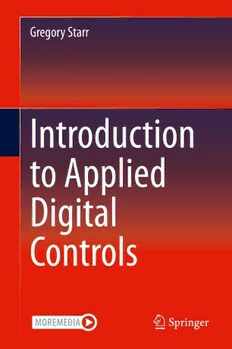Table Of ContentGregory Starr
Introduction
to Applied
Digital
Controls
Introduction to Applied Digital Controls
Gregory Starr
Introduction to Applied
Digital Controls
GregoryStarr
UniversityofNewMexico
Albuquerque,NM,USA
Additionalmaterialtothisbookcanbedownloadedfromhttp://www.springer.com
ISBN978-3-030-42809-9 ISBN978-3-030-42810-5 (eBook)
https://doi.org/10.1007/978-3-030-42810-5
©SpringerNatureSwitzerlandAG2020
Thisworkissubjecttocopyright.AllrightsarereservedbythePublisher,whetherthewholeorpartof
thematerialisconcerned,specificallytherightsoftranslation,reprinting,reuseofillustrations,recitation,
broadcasting,reproductiononmicrofilmsorinanyotherphysicalway,andtransmissionorinformation
storageandretrieval,electronicadaptation,computersoftware,orbysimilarordissimilarmethodology
nowknownorhereafterdeveloped.
Theuseofgeneraldescriptivenames,registerednames,trademarks,servicemarks,etc.inthispublication
doesnotimply,evenintheabsenceofaspecificstatement,thatsuchnamesareexemptfromtherelevant
protectivelawsandregulationsandthereforefreeforgeneraluse.
Thepublisher,theauthorsandtheeditorsaresafetoassumethattheadviceandinformationinthisbook
arebelievedtobetrueandaccurateatthedateofpublication.Neitherthepublishernortheauthorsor
theeditorsgiveawarranty,expressedorimplied,withrespecttothematerialcontainedhereinorforany
errorsoromissionsthatmayhavebeenmade.Thepublisherremainsneutralwithregardtojurisdictional
claimsinpublishedmapsandinstitutionalaffiliations.
ThisSpringerimprintispublishedbytheregisteredcompanySpringerNatureSwitzerlandAG
Theregisteredcompanyaddressis:Gewerbestrasse11,6330Cham,Switzerland
Preface
Thisbookisintendedtogivetheseniororfirst-yeargraduatestudentsinmechanical
engineeringanintroductiontodigitalcontrolofdynamicsystemswithanemphasis
on applications. The nature of the book is biased towards clarity rather than
mathematicalrigor,althoughthedevelopmentofimportantmaterialiscomplete.
Both transform-based (classical) and state-space (modern) control design are
addressed.Theroot-locusdesignmethodinthez-planeisusedforclassical,while
pole-placement plus a state estimator (where needed) is used for modern control.
The topic of model building is treated using parameter identification by least-
squares.
A brief review of the chapters is as follows: Chap.1 introduces the idea of
digitalcontrolandsomebasicterminology.Chapter2coverslineardiscretesystems
and introduces the z-transform. Chapter 3 presents several methods for finding
discrete approximations to continuous systems. Mathematical modeling of the
sampling process is treated in Chap.4, along with the phenomenon of aliasing.
Chapter5coversclassicalcontrolsystemdesigninthez-planeusingroot-locus.A
reviewofstate-spaceanalysisofcontinuoussystemsispresentedinChap.6,while
Chap.7extendsthistostate-spacedesignofdigitalcontrolsystems.Finally,abrief
introductiontosystemidentificationusingleast-squaresispresentedinChap.8.
Thebookisintendedforaone-semesterorone-quartercourseandcanbefully
covered in that time. Students are expected to have had a prerequisite course in
continuouscontrolsystemanalysisanddesign.
In keeping with the philosophy of this book, the author encourages the use
of laboratory demonstrations and projects as resources allow. The appendices
document demonstrations (Appendix A) and projects (Appendices B and C) that
are used at The University of New Mexico. The use of such “hands-on” activities
greatlyenhancesstudents’understanding.
Finally, the accompanying interactive online material developed by Prof. Greg
Mason is pedagogically significant; its use is encouraged. This URL is sub-
ject to change, depending on whether Springer hosts the interactive material
(http://applieddigitalcontrols.com). The ability to immediately see the effect of
v
vi Preface
parameter choice is a significant learning tool; students will benefit from this
resource. The data for performing system identification for the Final Project are
alsoavailableatthiswebsite.
Albuquerque,NewMexico,USA GregoryStarr
Acknowledgements
ThanksmustfirstgotoProf.GeneFranklinofStanfordUniversity,forintroducing
metodigitalcontrol.TheencouragementofProf.GregMasonofSeattleUniversity
wasinstrumental;withouthim,thispublicationwouldneverhavehappened.
The development of the hardware for the Final Project (Appendices B and C)
wasdonebyDr.DavidG.Wilson;thenagraduatestudentatTheUniversityofNew
Mexico.
Finally, thanks go to my wife Anne and four sons Paul, Keith, Mark, and Jeff
for being patient during the preparation and revision of this manuscript—also my
late father Duke Starr who recognized that any kid who liked mathematics and
motorcyclescannotbeallbad.
vii
Contents
1 IntroductionandScopeofthisBook....................................... 1
1.1 ContinuousandDigitalControl....................................... 1
1.1.1 FeedbackControl............................................. 1
1.1.2 DigitalControl................................................ 2
1.2 PhilosophyandTextCoverage........................................ 4
2 LinearDiscreteSystemsandtheZ-Transform........................... 7
2.1 ChapterOverview ..................................................... 7
2.2 LinearDifferenceEquations .......................................... 8
2.2.1 SolvingDifferenceEquations................................ 9
2.3 TheZ-TransformandtheDiscreteTransferFunction............... 11
2.3.1 Thez-Transform.............................................. 12
2.3.2 DiscreteTransferFunction................................... 12
2.3.3 BlockDiagramsofDiscreteSystems........................ 14
2.3.4 GoingFromTransferFunctiontoDifferenceEquation..... 15
2.3.5 RelationoftheTransferFunctiontotheUnitPulse
Response ...................................................... 16
2.4 DynamicResponseofDiscreteSystems ............................. 17
2.4.1 UnitStep ...................................................... 18
2.4.2 Exponential ................................................... 19
2.4.3 DampedSinusoid............................................. 20
2.4.4 RelationshipBetweenz-PlanePolesandTransient
Response ...................................................... 21
2.4.5 EffectofZerosonDynamicResponse....................... 23
2.5 CorrespondenceBetweenDiscreteandContinuousSignals ........ 23
2.6 FrequencyResponseofDiscreteSystems............................ 26
2.7 Z-TransformProperties ............................................... 26
2.7.1 InverseTransforming......................................... 28
2.8 AWordAboutLTISystemsandMATLABFunctions .............. 33
2.8.1 LTISystems................................................... 33
2.8.2 OverloadedFunctions ........................................ 33
2.9 TableofZ-Transforms ................................................ 35
ix
x Contents
3 DiscreteSimulationofContinuousSystems .............................. 39
3.1 ChapterOverview ..................................................... 39
3.2 DiscreteSimulationUsingNumericalIntegration................... 40
3.2.1 ForwardRectangularRule(Euler’sRule) ................... 41
3.2.2 BackwardRectangularRule.................................. 42
3.2.3 TrapezoidalRule.............................................. 43
3.2.4 PrewarpedTrapezoidalRule ................................. 46
3.3 Pole-ZeroMapping.................................................... 49
3.4 ComparisonofSimulations ........................................... 50
3.5 UsingMATLABinDiscreteSimulation ............................. 51
3.5.1 FindingTransferFunctionfromLTISystem................ 54
3.6 ImplementationofDifferenceEquationsinRealTime.............. 54
3.6.1 DirectRealization............................................. 55
3.6.2 CanonicalRealization ........................................ 56
4 SampledDataSystems ...................................................... 59
4.1 Introduction............................................................ 59
4.2 TheSamplingProcessasImpulseModulation....................... 59
4.3 FrequencySpectraofSampledSignals—Aliasing................... 62
4.3.1 FourierTransformandFourierSeries ....................... 62
4.4 DesamplingorSignalReconstruction................................ 67
4.4.1 ImpulseResponseoftheIdealDesamplingFilter........... 68
4.4.2 TheZOHasaDesamplingFilter ............................ 69
4.5 BlockDiagramAnalysis .............................................. 71
4.5.1 TwoBlockswithaSamplerBetweenThem................. 71
4.5.2 TwoBlocksWithoutaSamplerBetweenThem............. 73
4.5.3 ResponseBetweenSamples.................................. 77
5 DesignUsingTransformMethods.......................................... 79
5.1 Introduction............................................................ 79
5.2 ExampleSystemandSpecifications.................................. 80
5.2.1 Steady-StateAccuracy........................................ 82
5.2.2 TransientResponse........................................... 84
5.2.3 DisturbanceRejection........................................ 87
5.2.4 ControlEffortandGainDistribution ........................ 89
5.2.5 ParameterSensitivity......................................... 90
5.3 Designinthes Plane,thenDiscretizeController.................... 90
5.4 DirectDesigninthezPlane........................................... 94
5.5 AnotherDesignExample.............................................. 98
5.6 ModelingUsingSimulink............................................. 107
5.6.1 CreatingtheSimulinkModel ................................ 108
5.7 PIDControl(ModeControllers)...................................... 109
5.7.1 ProportionalControl.......................................... 110
5.7.2 DerivativeAction............................................. 110
5.7.3 IntegralAction................................................ 111
5.7.4 PDControl.................................................... 111
Contents xi
5.7.5 PIControl ..................................................... 111
5.7.6 PIDControl ................................................... 112
5.8 SomeCommentsontheStepInput................................... 112
5.8.1 HardwareConcerns........................................... 112
5.8.2 ControllerConcerns .......................................... 113
6 State-SpaceAnalysisofContinuousSystems ............................. 115
6.1 Introduction............................................................ 115
6.2 SystemDescription.................................................... 116
6.2.1 StateEquationandOutputEquation......................... 116
6.2.2 StateEquationfromTransferFunction...................... 118
6.2.3 TransferFunctionfromState-VariableDescription......... 118
6.3 DifferentState-SpaceRepresentations................................ 120
6.3.1 StateVariableTransformation................................ 121
6.3.2 ControlCanonicalForm...................................... 121
6.3.3 Diagonal(ModalorDecoupled)Form....................... 123
6.4 MATLABTools........................................................ 124
6.4.1 Transform↔State-Space.................................... 125
6.4.2 Eigenvalues,Eigenvectors,andDiagonalization............ 126
6.4.3 DynamicResponseofState-SpaceForms................... 128
7 DigitalControllerDesignusingStateSpaceMethods ................... 131
7.1 Introduction............................................................ 131
7.2 CanonicalState-SpaceFormsfromTransferFunction .............. 131
7.3 SolutiontotheStateEquation ........................................ 134
7.3.1 HomogeneousSolution....................................... 134
7.3.2 ParticularSolution............................................ 135
7.3.3 CalculatingSystemandOutputMatrices.................... 137
7.4 ControlLawDesign................................................... 137
7.4.1 PolePlacement................................................ 138
7.4.2 SelectingSystemPoleLocations ............................ 141
7.4.3 ControllabilityandtheControlCanonicalForm............ 142
7.4.4 Ackermann’sRuleandaTestforControllability ........... 143
7.4.5 MATLABTools............................................... 145
7.4.6 PolesandZeros............................................... 145
7.4.7 MoreonControllability ...................................... 147
7.5 StateEstimatorDesign ................................................ 148
7.5.1 PredictionEstimator.......................................... 148
7.5.2 ObservabilityandAckermann’sFormula.................... 150
7.5.3 MATLABTools............................................... 150
7.6 Regulator:ControlLawPlusEstimator .............................. 151
7.6.1 ControllerTransferFunction................................. 157
7.7 CurrentandReduced-OrderEstimators .............................. 161
7.7.1 CurrentEstimator............................................. 161
7.7.2 Reduced-OrderEstimators ................................... 163

